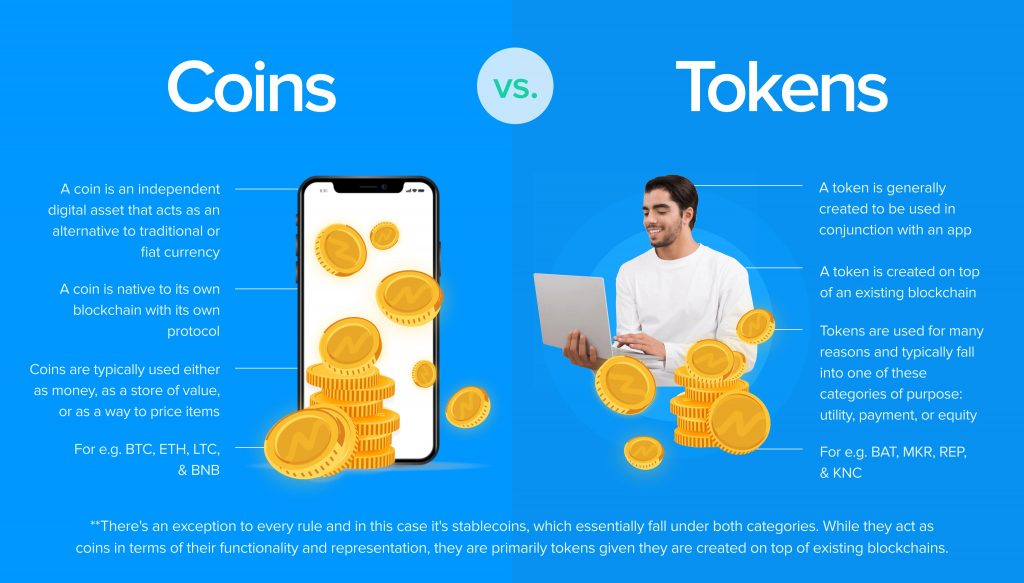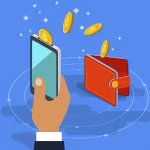In the bitcoin sector, there are a lot of new phrases that can be perplexing. Tokens, coins, and altcoins, for example, appear to be the same thing. However, this is not the case. What is the difference between a token and a coin, and what is the distinction between coins and altcoins?
Read more: What is token in the world of cryptocurrencies
What is the definition of a coin?
The coin is a cryptocurrency that is part of the blockchain network. Bitcoin, Litecoin, and Ether are all currency that may be found on your blockchain. Bitcoins, for example, are based on the bitcoin blockchain, whereas ethers are based on the Ethereum blockchain.
Parts can be transferred from one user to the next. The real physical parts, on the other hand, do not move in a direct manner. Coins are data codes that are recorded in a massive database known as the blockchain.
Sorts of components
In the cryptocurrency sector, there are thousands of distinct coins. There are two types of digital coins: digital coins and altcoins. A separate blockchain exists for digital currency. The most well-known instances are:
- Bitcoins (Bitcoin blockchain)
- Ether (Ethereum blockchain)
- Monero (Monero blockchain).
The Bitcoin blockchain is used to create and generate altcoins. They are the most common type of currency created from the Bitcoin code. The following are the most well-known altcoins:
LTC; DOG; personal coin
Apps
Coins are the most widely accepted form of payment. They can be used for a variety of purposes, including:
- Money transfer – money can be sent to any country;
- Coins have purchasing power and can be used to pay for products and services;
- Making investments is especially important in the case of cryptocurrencies, whose value is constantly rising.
BTC is exclusively used as a payment method. There isn’t any other reason. However, there are some portions that are quite useful, such as:
Ethers are used to carry out transactions on the Ethereum network. They’re also at the heart of the smart contract system. These are applications that make use of the blockchain technology. They function as a digital contract with a set of rules attached. Both parties to the smart contract can take on certain responsibilities, which are guaranteed by blockchain. Tokens are likewise based on Ethereum, however they must be shipped using ETH.
You can receive dividends by keeping NEO in your wallet. “Gas” is the term for these dividends. When you transmit a token to the NEO system, you must pay a transaction fee in gas, similar to how you would pay fees on the Ethereum network using ether. NEO’s blockchain also allows for the creation of new tokens.
Dash gives community members the ability to make important decisions. If a suggestion to improve the system is made, for example, those with enough Dash Coins can vote for or against the modifications.
What exactly is a token?

Tokens are frequently confused with cryptocurrency currencies, but this is incorrect: tokens are built on top of existing blockchains. In fact, Ethereum is the most popular blockchain platform for tokens, mainly to the development and ease of smart contracts.
The ERC-20 standard is used by the coins based on this network. Other token creation platforms, like as NEO, Waves, Lisk, and Stratis, exist at the same time. Other varieties exist, such as NEO tokens, which are referred to as NEP-5.
On any of the blockchains described, any user with appropriate knowledge and skills can create a new token. Development necessitates the expenditure of some funds. If the token is ERC-20, for example, the developer will need to send an ETH to Ether miners to confirm the transaction (token development).
It’s also worth noting that the commission must be paid for all token-based transactions throughout the system, not only development. This necessitates the use of Ether in any Ethereum-based application. In order to make transfers between the application and the user, ETH allows you to send application tokens from one person to another. We can recollect coin transactions in which the commission is paid to the individuals who confirm the transactions.
Since the developer of the decentralized application and token does not have to develop a new blockchain, the developer saves money and time.
The following are some of the benefits of using tokens:
- Create a decentralized database with data that can’t be updated or removed;
- Streamlining business processes; increasing security; simplifying the method for validating all transactions;
- Providing a comfortable interface for users and developers of a decentralized application; the ability to optimize the website’s functioning and expand its capabilities.
Tokens of various kinds
Tokens are divided into four categories:
Investor. Because these tokens are utilized as stocks and a source of income for the corporation, they can be compared to an investor agreement. They make it possible for the owner to receive dividends. They’re also comparable to stocks, bonds, and derivatives. Initial Coin Offerings (ICOs) are where investor tokens are most commonly used (ICOs). This is becoming a more popular way for new businesses to raise funds. TSLA.CX, which represents the value of Tesla shares on the Nasdaq exchange, is an example of a tokenized asset.
Service. These are unregulated tokens that grant access to multiple platforms’ functionality, as well as specific goods and services. These tokens provide digital access to the application or service via the blockchain infrastructure, according to the FINMA judgment, but they have no investment value. They’re similar to tokens purchased for slot machines or the subway. CVC is an example of a utility token (more on this in the next block).
Okay. Common assets, as well as various commodities, are engraved on these tokens (national currency, gold, oil products). Stablecoins are included in this category. Their key characteristic is that they are stable. USDT is the best example of a stablecoin, as it is always worth one dollar.
Payment. These tokens can be used to pay for goods and services as well as to send money. Payment tokens also make it possible to put the anti-money laundering rules of the FINMA Act into practice. Except for investment tokens, this category encompasses all of the categories stated above.
Apps
The majority of tokens are used in decentralized apps (dApps). Users can decide how many tokens they wish to create and where they will be distributed in the future when they develop new tokens. Tokens are frequently used to unlock the programs’ capabilities. Musicoin, for example, provides access to the same-named service function.
Holders of tokens can watch videos and listen to music. Binance is a cryptocurrency exchange that has its own cryptocurrency token. The commission will be lowered by two times if the user uses it during the transaction.
Some tokens are made to look like real objects. For example, suppose you wanted to use a smart contract to sell a house. You can’t put your house into a smart contract literally. Instead, you can use a token in the contract to represent your property. WePower (CAP) is an excellent example of a token that represents a physical object (electricity). WePower is a blockchain-based service that allows users to purchase and sell electricity using smart contracts. A specified amount of electricity is represented by the CAP token.
CVC is another example of a token. It’s employed in the Civic program, which is decentralized. The service’s purpose is to keep track of encrypted Ethereum blockchain credentials. You can verify your identification in a cost-efficient, reliable, and effective manner by utilizing the app. Let’s look at how this works in more detail.
Let’s say you’re arranging a vacation to another country. At several locations throughout the trip, you will be required to identify yourself. The airline is the first of these locations. If it’s a Civic partner, you’ll get a QR code with a form to fill out with your personal information.
You provide information about yourself to the airline immediately from your smartphone when you use the service. The information is encrypted and saved on the phone. This helps to keep them safe from thievery. A fingerprint, such as an iris scan, can verify that the data being communicated is yours.
You can then use the same phone to verify your identity in several locations while on the move (airports, hotels). Blockchain information verification can be done by any organization where you verify your identification.
Verification actions are performed on the service token itself. Checks issued by banks and government bodies can be used to pay.
The CVC token is used to pay for the website’s services, as you can see. It’s impossible to do this with bitcoin, ether, or NEO. However, because the token is based on the Ethereum blockchain, each operation requires ETH to pay for the miners’ efforts.




